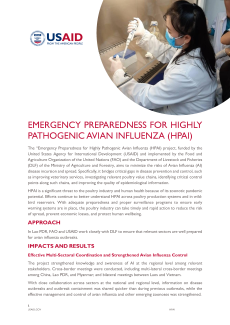The “Emergency Preparedness for Highly Pathogenic Avian Influenza (HPAI) project, funded by the United States Agency for International Development (USAID) and implemented by the Food and Agriculture Organization of the United Nations (FAO) and the Department of Livestock and Fisheries (DLF) of the Ministry of Agriculture and Forestry, aims to minimize the risks of Avian Influenza (AI) disease incursion and spread. Specifically, it bridges critical gaps in disease prevention and control, such as improving veterinary services, investigating relevant poultry value chains, identifying critical control points along such chains, and improving the quality of epidemiological information.
HPAI is a significant threat to the poultry industry and human health because of its zoonotic pandemic potential. Efforts continue to better understand HPAI across poultry production systems and in wild-bird reservoirs. With adequate preparedness and proper surveillance programs to ensure early warning systems are in place, the poultry industry can take timely and rapid action to reduce the risk of spread, prevent economic losses, and protect human wellbeing.
APPROACH
In Lao PDR, FAO and USAID work closely with DLF to ensure that relevant sectors are well prepared for avian influenza outbreaks.
IMPACTS AND RESULTS
Effective Multi-Sectoral Coordination and Strengthened Avian Influenza Control
The project strengthened knowledge and awareness of AI at the regional level among relevant stakeholders. Cross-border meetings were conducted, including multi-lateral cross-border meetings among China, Lao PDR, and Myanmar; and bilateral meetings between Laos and Vietnam.
With close collaboration across sectors at the national and regional level, information on disease outbreaks and outbreak containment was shared quicker than during previous outbreaks, while the effective management and control of avian influenza and other emerging zoonoses was strengthened.
Bolstering National Surveillance System
The project undertook surveillance activities in high-risk target areas to monitor HPAI virus circulation and the potential transmission routes, such as at border checkpoints, live bird markets, and collection points. In Phongsaly, Luang Namtha, Oudomxay, Luang Prabang, Sayabouly, Vientiane Province, and Vientiane Capital, 4,252 diagnostic specimens were collected and tested for HPAI.
Knowledge of surveillance-related topics were further developed. Forty-four field staff at the provincial and district levels were trained on outbreak investigation and active surveillance. Five staff at the National Animal Health Laboratory were regularly trained for the best performance of laboratory diagnostics for emerging threats of HPAI and other zoonotic diseases.
Emergency Response and Risk Reduction
The project trained 25 participants and four trainers to review and conduct poultry value chain studies in five provinces of Lao PDR. The results enabled the identification of risk reduction measures for HPAI infection along the value chain. The project developed a biosecurity improvement plan for farm and live bird markets for effective disease prevention management.
The Government’s capacity to investigate the HPAI outbreak and identify its sources and drivers was strengthened. Outbreak investigations were successfully conducted (such as the case of HPAI subtype H5N6 in Sayabouly Province and HPAI subtype H5N1 in Luang Prabang Province). A series of joint simulation exercises were conducted to ensure government staff work closely together and are ready for emergency outbreaks.
A Joint National Preparedness and Contingency plan to respond to AI H7N9 and H5N1 was developed and adopted by the Ministry of Agriculture and Forestry and Ministry of Health.


